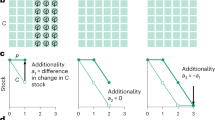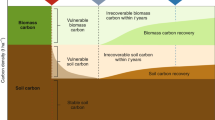Abstract
Climate change is damaging ecosystems throughout the world with serious implications for human well-being. Quantifying the benefits of reducing emissions requires understanding these costs, but the unique and non-market nature of many goods provided by natural systems makes them difficult to value. Detailed representation of ecological damages in models used to calculate the costs of greenhouse gas emissions has been largely lacking. Here, we have expanded a cost–benefit integrated assessment model to include natural capital as a form of wealth. This brings benefits to people through non-use existence value and as an input into the production of ecosystem services and market goods. In our model, using central estimates for all parameters, optimal emissions reach zero by the year 2050, limiting warming to 1.5 °C by the year 2100. We used Monte Carlo analysis to examine the influence of several key uncertain model parameters, and examined the effect of adaptive investments in natural systems that partially offset climate damages. Overall, we show that accounting for the use and non-use value of nature has large implications for climate policy. Our analysis suggests that better understanding climate impacts on natural systems and associated welfare effects should be a high priority for future research.
This is a preview of subscription content, access via your institution
Access options
Access Nature and 54 other Nature Portfolio journals
Get Nature+, our best-value online-access subscription
$29.99 / 30 days
cancel any time
Subscribe to this journal
Receive 12 digital issues and online access to articles
$119.00 per year
only $9.92 per issue
Buy this article
- Purchase on Springer Link
- Instant access to full article PDF
Prices may be subject to local taxes which are calculated during checkout





Similar content being viewed by others
Data availability
Results of the simulations are available at https://github.com/BerBastien/GreenDICE/tree/master/Results
Code availability
GreenDICE code is available at www.GitHub.com/BerBastien/GreenDICE
References
Pascual, U. et al. Valuing nature’s contributions to people: the IPBES approach. Curr. Opin. Environ. Sustain. 26, 7–16 (2017).
De Groot, R. S., Alkemade, R., Braat, L., Hein, L. & Willemen, L. Challenges in integrating the concept of ecosystem services and values in landscape planning, management and decision making. Ecol. Complex. 7, 260–272 (2010).
Turner, R. K. et al. Valuing nature: lessons learned and future research directions. Ecol. Econ. 46, 493–510 (2003).
Agarwala, M., Atkinson, G., Baldock, C. & Gardiner, B. Natural capital accounting and climate change. Nat. Clim. Change 4, 520–522 (2014).
Jones-Walters, L. & Mulder, I. Valuing nature: the economics of biodiversity. J. Nat. Conserv. 17, 245–247 (2009).
Gomes, V. H. F., Vieira, I. C. G., Salomão, R. P. & ter Steege, H. Amazonian tree species threatened by deforestation and climate change. Nat. Clim. Change 9, 547–553 (2019).
Rogers, L. A. et al. Shifting habitats expose fishing communities to risk under climate change. Nat. Clim. Change 9, 512–516 (2019).
Roberts, C. P., Allen, C. R., Angeler, D. G. & Twidwell, D. Shifting avian spatial regimes in a changing climate. Nat. Clim. Change 9, 562–566 (2019).
Pecl, G. T. et al. Biodiversity redistribution under climate change: impacts on ecosystems and human well-being. Science 355, eaai9214 (2017).
Settele, J. et al. in Climate Change 2014: Impacts, Adaptation, and Vulnerability (eds. Field, C. B. et al.) 271–360 (IPCC, Cambridge Univ. Press, 2015).
Warszawski, L. et al. A multi-model analysis of risk of ecosystem shifts under climate change. Environ. Res. Lett. 8, 044018 (2013).
Parmesan, C. & Yohe, G. A globally coherent fingerprint of climate change impacts across natural systems. Nature 421, 37–42 (2003).
Global Assessment Report on Biodiversity and Ecosystem Services (Intergovernmental Science-Policy Platform on Biodiversity and Ecosystem Services, 2019).
Millennium Ecosystem Assessment Ecosystems and Human Well-being: Synthesis (Island Press, 2005).
Drupp, M. A. Limits to substitution between ecosystem services and manufactured goods and implications for social discounting. Environ. Resour. Econ. 69, 135–158 (2018).
Hoel, M. & Sterner, T. Discounting and relative prices. Clim. Change 84, 265–280 (2007).
Sterner, T. & Persson, U. M. An even sterner review: introducing relative prices into the discounting debate. Rev. Environ. Econ. Policy 2, 61–76 (2008).
Drupp, M. A. & Hänsel, M. C. Relative prices and climate policy: how the scarcity of non-market goods drives policy evaluation. Am. Econ. J. Econ. Policy https://www.aeaweb.org/articles?id=10.1257/pol.20180760 (2020).
Tol, R. S. The damage costs of climate change: a note on tangibles and intangibles, applied to DICE. Energy Policy 22, 436–438 (1994).
Kopp, R. E., Golub, A., Keohane, N. O. & Onda, C. The influence of the specification of climate change damages on the social cost of carbon. Economics-Kiel 6, 1–40 (2012).
Moore, F. C. & Diaz, D. B. Temperature impacts on economic growth warrant stringent mitigation policy. Nat. Clim. Change 5, 127–131 (2015).
Tol, R. S. Estimates of the damage costs of climate change. Part 1: benchmark estimates. Environ. Resour. Econ. 21, 47–73 (2002).
Diaz, D. & Moore, F. Quantifying the economic risks of climate change. Nat. Clim. Change 7, 774–782 (2017).
Nordhaus, W. D. & Tobin, J. in Economic Research: Retrospect and Prospect Vol. 5 1–80 (NBER, 1972).
Nordhaus, W. & Sztorc, P. DICE 2013R: Introduction and User’s Manual (retrieved November, 2019); https://go.nature.com/3kmwMc5
Barbier, E. B. The concept of natural capital. Oxf. Rev. Econ. Policy 35, 14–36 (2019).
Arrow, K. J., Dasgupta, P., Goulder, L. H., Mumford, K. J. & Oleson, K. Sustainability and the measurement of wealth. Environ. Dev. Econ. 17, 317–353 (2012).
Lange, G.-M., Wodon, Q. & Carey, K. The Changing Wealth of Nations 2018: Building a Sustainable Future (The World Bank, 2018).
Hackett, S. B. & Moxnes, E. Natural capital in integrated assessment models of climate change. Ecol. Econ. 116, 354–361 (2015).
Dietz, S. & Stern, N. Endogenous growth, convexity of damage and climate risk: how Nordhaus’ framework supports deep cuts in carbon emissions. Econ. J. 125, 574–620 (2015).
Glotter, M. J., Pierrehumbert, R. T., Elliott, J. W., Matteson, N. J. & Moyer, E. J. A simple carbon cycle representation for economic and policy analyses. Clim. Change 126, 319–335 (2014).
Arrow, K. et al. Report of the NOAA panel on contingent valuation. Fed. Regist. 58, 4601–4614 (1993).
Bateman, I. & Willis, K. (eds) Valuing Environmental Preferences: Theory and Practice of the Contingent Valuation Method in the US, EU, and Developing Countries (Oxford Univ. Press, 2001).
Champ, P. A., Boyle, K. J., Brown, T. C. & Peterson, L. G. (eds) A Primer on Nonmarket Valuation Vol. 3 (Springer, 2003).
Technical Support Document: - Social Cost of Carbon for Regulatory Impact Analysis - Under Executive Order 12866 (Interagency Working Group on Social Cost of Carbon, United States Government, 2010).
Beckage, B. et al. Linking models of human behaviour and climate alters projected climate change. Nat. Clim. Change 8, 79–84 (2018).
Breiman, L. Manual On Setting Up, Using, And Understanding Random Forests V3.1 https://www.stat.berkeley.edu/ breiman/Using_random_forests_V3.1.pdf (2002).
Lemoine, D. & Traeger, C. P. Economics of tipping the climate dominoes. Nat. Clim. Change 6, 514–519 (2016).
Cai, Y. & Lontzek, T. S. The social cost of carbon with economic and climate risks. J. Polit. Econ. 127, 2684–2734 (2019).
Traeger, C. P. A 4-stated DICE: quantitatively addressing uncertainty effects in climate change. Environ. Resour. Econ. 59, 1–37 (2014).
Crost, B. & Traeger, C. Optimal climate policy: uncertainty versus Monte Carlo. Econ. Lett. 120, 552–558 (2013).
Statistical Office of the European Union Environmental Protection Expenditure Accounts: Handbook (Eurostat, 2017).
Diaz, D. B. Estimating global damages from sea level rise with the Coastal Impact and Adaptation Model (CIAM). Clim. Change 137, 143–156 (2016).
De Bruin, K. C., Dellink, R. B. & Tol, R. S. AD-DICE: an implementation of adaptation in the DICE model. Clim. Change 95, 63–81 (2009).
Urban, M. C. Accelerating extinction risk from climate change. Science 348, 571–573 (2015).
Chaplin-Kramer et al. Global modeling of nature’s contributions to people. Science 366, 255–258 (2019).
Moore, F. C. et al. Mimi-PAGE, an open-source implementation of the PAGE09 integrated assessment model. Sci. Data 5, 180187 (2018).
Anthoff, D., Plevin, R., Kingdon, C. & Rennels, L. Mimi: An Integrated Assessment Modeling Framework (2020); https://www.mimiframework.org/
Solow, R. M. Is the end of the world at hand? Challenge 16, 39–50 (1973).
Stiglitz, J. E. in Scarcity and Growth Reconsidered (ed. Smith, V. K.) 36–66 (The Johns Hopkins Univ. Press, 1979).
Brandt, N., Schreyer, P. & Zipperer, V. Productivity measurement with natural capital. Rev. Income Wealth 63, S7–S21 (2017).
Costanza et al. Changes in the global value of ecosystem services. Glob. Environ. Change 26, 152–158 (2014).
Howard, P. H. & Sterner, T. Few and not so far between: a meta-analysis of climate damage estimates. Environ. Resour. Econ. 68, 197–225 (2017).
Hsiang et al. Estimating economic damage from climate change in the United States. Science 356, 1362–1369 (2017).
Yamaguchi, R. & Managi, S. Backward-and forward-looking shadow prices in inclusive wealth accounting: an example of renewable energy capital. Ecol. Econ. 156, 337–349 (2019).
Acknowledgements
This study was supported by the National Science Foundation (award number 1924378: ‘CNH2-S: Understanding the Coupling Between Climate Policy and Ecosystem Change’), the Hellman Fellows Program (F.C.M.), the Fulbright-García Robles Fellowship (B.A.B.-O.) and a UC Davis John Muir Institute of the Environment Fellowship (B.A.B.-O.).
Author information
Authors and Affiliations
Contributions
B.A.B.-O. and F.C.M. conceived the study, analysed the results and prepared the manuscript. B.A.B.-O. coded the model and performed the simulations.
Corresponding author
Ethics declarations
Competing interests
The authors declare no competing interests.
Additional information
Publisher’s note Springer Nature remains neutral with regard to jurisdictional claims in published maps and institutional affiliations.
Extended data
Extended Data Fig. 1 Effects of different estimates of natural capital.
Effects of different estimates of the natural capital-adjusted total factor productivity and natural capital current value relative to current manufactured capital. Red stars give values using the preferred parameter estimates. Size of circles represents the current global estimate of natural capital value with respect to manufactured capital.
Extended Data Fig. 2 Three levels of adaptation costs.
Key policy variables under welfare-maximizing conditions of three levels of adaptation costs. Dotted line is standard DICE, and dashed-dotted line is GreenDICE without investments.
Extended Data Fig. 3 Investments on natural capital stock.
Welfare-maximizing investments on natural capital stock.
Supplementary information
Supplementary Information
Supplementary Figs. 1 and 2, Tables 2–6 and notes.
Supplementary Table 1
Key parameters and functional forms introduced in GreenDICE. If not specified, the parameter is the same as in DICE 2013R.
Rights and permissions
About this article
Cite this article
Bastien-Olvera, B.A., Moore, F.C. Use and non-use value of nature and the social cost of carbon. Nat Sustain 4, 101–108 (2021). https://doi.org/10.1038/s41893-020-00615-0
Received:
Accepted:
Published:
Issue Date:
DOI: https://doi.org/10.1038/s41893-020-00615-0
This article is cited by
-
Unequal climate impacts on global values of natural capital
Nature (2024)
-
The economic commitment of climate change
Nature (2024)
-
Relative Price Changes of Ecosystem Services: Evidence from Germany
Environmental and Resource Economics (2024)
-
The historical social cost of fossil and industrial CO2 emissions
Nature Climate Change (2023)
-
An assessment of different transition pathways to a green global economy
Communications Earth & Environment (2023)



